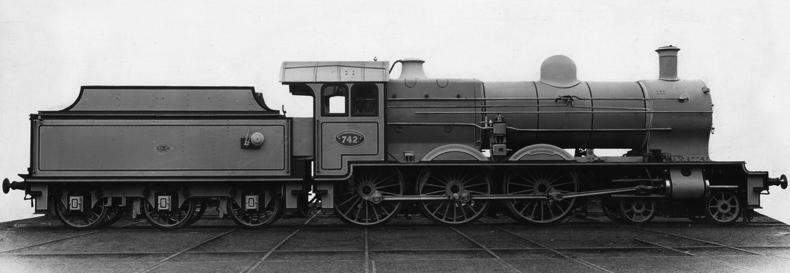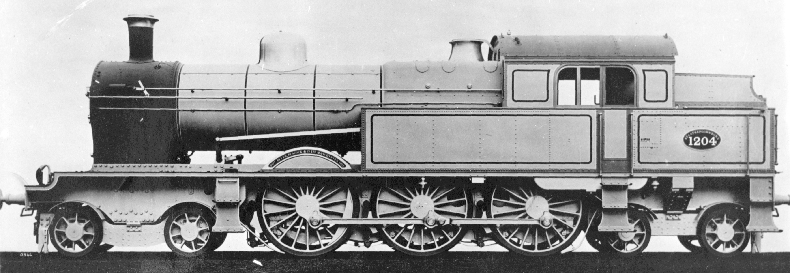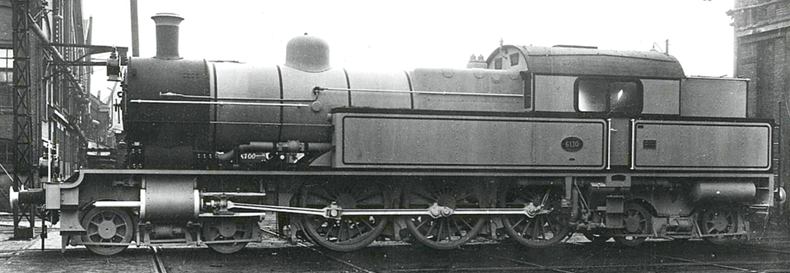Garrattfan's Modelrailroading Pages

NS 6000 class
History of the 6000 class
The Dutch 4-6-x family
SS 700 / NS 3700
Starting from 1910 the, brace yourself, Maatschappij tot Explotatie van Staatsspoorwegen (Company of Exploitation of State Railways), colloquially abridged to the then unsuspected S.S., took delivery 2-6-0 tender engines of the 700 class, a class eventually totalling 120 examples by 1928, well after the SS had merged with the HIJSM to form the NS (Dutch Railways).
| Built: 120 | In service: 1910-1928 | Last out of service: 1957 | Preserved: 1 |
Builder's photo Werkspoor 1912. Source: ©Collection Het Utrechts Archief, Catalogue number 808476 |
|||
SS 1200 / NS 6000
The 700 class proved to satisfy both operating staff, maintenance staff and management alike and from this a desire arose to develop a tank version for similar duties but for shorter lines with no or too small turntables. As many of the lines this tank version was to serve had a lighter laid rail the intended four cylinder design proved too heavy and the motion was consequently reduced to two inside cylinders only. To compensate for this the cylinders were enlarged to 508 mm diameter (the 700 class having 4x400 mm). It also has a smaller boiler. The choice between a 4-6-2 and a 4-6-4 was decided in favour of the latter to carry 8 m3 coal without exceeding the 15 tons axle load. The SS took delivery of the first six examples in 1913, built by Beyer Peacock. These first six engines had short water tanks letting the splasher of the leading coupled axle entirely free as seen on the photo below. These engines clearly satisfied needs and a follow-up order of 24 was placed only months after the first six had entered service. Even before 1913 was out a third order for another 10 was placed, bringing the total to 40. The later deliveries had longer water tanks, covering the splasher of the leading coupled axle about halfway. The first six engines of the second order had only been delivered in 1914 when WWI broke out greatly hampering further deliveries. The Railway Operation Division of the War Department seized fourteen of the engines before they left the UK and diverted them to Northern France. After the war they ended up in service of the Nord company and eventually never saw service in the Netherlands. The class fulfilled its purpose very well, but no further orders followed, not even to compensate for the loss of the fourteen "Frenchised" loco's. The formation of the NS by the merger of SS, HIJSM, NCS and NBDS in 1917-1919 and the ensuing difficult years of harmonisation and consolidation may be the main cause of this. But the 1922 plan for quick and whole sale electrification and the deep economical crisis may have been contributing factors. The class served well and somewhat obscurely in the 1920s and 1930s mostly in the centre of the country. WWII brought significant changes as the really heavy engines were required to pull the Wehrmacht transports and the 6000s stepped up to run the heavier services. By war's end only four were operable, another eight were inoperable but within the Dutch borders and the remaining fourteen had disappeared "east". All of the latter returned until 1947, which in itself is remarkable as many locomotives were never seen again. Scrapping of the most seriously damaged locomotives reduced the class to 20. They had no significant services after the war. Scrapping started in 1954 and after 1955 they only minor work although a few held out until the very end of steam, the 6013 was the last one to be withdrawn on 28 November 1957. All were scrapped. Some of the bogies were used in the workshops in Tilburg as temporary bogies until the 1970's
| Built: 26 (40) | In service: 1913-1916 | Last out of service: 1957 | Preserved: None |
Builder's photo Beyer Peacock 1913. Source: ©Collection Het Utrechts Archief, Catalogue number 151429 |
|||
NS 6100
In the years after WWI many lightly laid railroads were provided with heavier infrastructure and the wish to build a true tank version of the NS 3700 class (ex-SS 700) was realised when the NS took delivery of 10 6100s 1929. True four cylinders single expansion albeit with a somewhat enlarged cylinder diameter of420 mm, equalling that of the last batch of the 3700, 3816-3820 which had been built only one year earlier.
| Built: 10 | In service: 1929 | Last out of service: 1957 | Preserved: None |
Builder's photo Werkspoor 1929. Source: ©Collection Het Utrechts Archief, Catalogue number 163261 |
|||
Main dimensions
| Subject | 3700 | 6000 | 6100 |
|---|---|---|---|
| Wheel arrangement | 4-6-0 | 4-6-4 | 4-6-4 |
| Grate area (m2) | 2.84 | 2.04 | 2.84 |
| Heated area firebox (m2) | 15 | 13 | 15 |
| Heated area tubes (m2) | 130 | 108 | 130 |
| Heated area superheater (m2) | 41 | 34 | 41 |
| Boiler pressure (bar) | 12 | 12 | 12 |
| Cyls | 4 | 2 | 4 |
| Cylinder diameter (mm) | 400 | 508 | 420 |
| Driver diameter (mm) | 1,850 | 1,850 | 1,850 |
| Water (m3) | 18 | 9 | 12 |
| Coal (tons) | 6 | 3 | 4 |
| Axle load (tons) | 16.0 | 16 | 18 |
| Weight loco and tender, operational (tons) |
115 | 93 | 108 |
| Length (mm) | 19,700 | 14,625 | 16,300 |
| Top speed (km/h) | 110 | 100 | 110 |
| Tractive effort (kgf) | 9,590 | 7,730 | 9,950 |
Remarks
- variations within a class are possible due to engineering changes over the span of delivery or due to different builders. I tried to find the typical values.
- The tractive effort is calculated with a factor as a percentage of the maximum boiler pressure, in Europe 70%.





Sign my
GuestBook